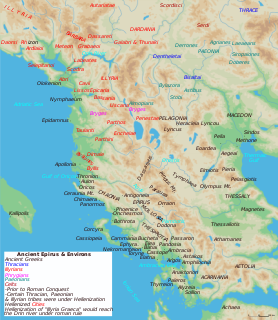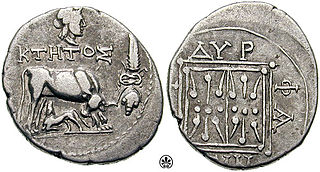Related Research Articles

In classical antiquity, Illyria was a region in the western part of the Balkan Peninsula inhabited by numerous tribes of people collectively known as the Illyrians. Illyrians spoke Illyrian languages, a group of Indo-European languages, which in ancient times perhaps had speakers in some parts in Southern Italy. The geographical term Illyris was used to define approximately the area of northern and central Albania down to the Aoös valley, including in most periods much of the lakeland area.

The Illyrians were a group of Indo-European tribes, who inhabited the western Balkan Peninsula in ancient times. They constituted one of the three main groups of Indo-European populations in the Balkans prior to 2000 BC, along with Thracians and Greeks.

In antiquity, Paeonia or Paionia was the land and kingdom of the Paeonians or Paionians.

The Dardani were a Paleo-Balkan tribe, which lived in a region which was named Dardania after their settlement there. The eastern parts of the region were at the Thraco-Illyrian contact zone. In archaeological research, Illyrian names are predominant in western Dardania, while Thracian names are mostly found in eastern Dardania. Thracian names are absent in western Dardania; some Illyrian names appear in the eastern parts. Thus, their identification as either an Illyrian or Thracian tribe has been a subject of debate; the ethnolinguistic relationship between the two groups being largely uncertain and debated itself as well. The correspondence of Illyrian names, including those of the ruling elite, in Dardania with those of the southern Illyrians suggests a "thracianization" of parts of Dardania. Strabo in his geographica mentions them as one of the three strongest Illyrian peoples, the other two being the Ardiaei and Autariatae.
The origin of the Albanians has long been a matter of debate within scholarship. The Albanians first appear in the historical record in Byzantine sources of the 11th century. At this point, they were already fully Christianized. The Albanian language forms a separate branch of Indo-European, first attested in the 15th century, and is considered to have evolved from one of the Paleo-Balkan languages of antiquity. The surviving pre-Christian Albanian culture shows that Albanian mythology and folklore are of Paleo-Balkanic origin and that almost all of their elements are pagan.
Taulantii or Taulantians were an Illyrian people that lived on the Adriatic coast of southern Illyria. They dominated at various times much of the plain between the Drin and the Aous. The centre of Taulantian kingdom is likely to have been in the area of Tirana, in the hinterland of Dyrrah/Epidamnus. The Taulantii are among the oldest attested Illyrian peoples, who established a powerful kingdom in southern Illyria. They are among the peoples who most marked Illyrian history, and thus found their place in the numerous works of historians in classical antiquity.

The Chaonians were an ancient Greek tribe that inhabited the region of Epirus located in the north-west of modern Greece and southern Albania. Together with the Molossians and the Thesprotians, they formed the main tribes of the northwestern Greek group. On their southern frontier lay another Epirote kingdom, that of the Molossians, to their southwest stood the kingdom of the Thesprotians, and to their north lived the Illyrian tribes. According to Virgil, Chaon was the eponymous ancestor of the Chaonians. By the 5th century BC, they had conquered and combined to a large degree with the neighboring Thesprotians and Molossians. The Chaonians were part of the Epirote League until 170 BC when their territory was annexed by the Roman Republic.

The Ardiaei were an Illyrian people residing on territory of present-day Albania, Kosovo, Montenegro, and Bosnia and Herzegovina between Adriatic coast on the south, Konjic on the north, along the Neretva river and its right bank on the west, extending to Lake Shkodra to the southeast. From the 3rd century BC to 168 BC the capital cities of the Ardiaean State were Rhizon and Scodra.

The Kingdom of Dardania was polity formed in the central Balkans in the region of Dardania during classical antiquity. It is named after the Dardani, a Paleo-Balkan tribe which formed its population and formed the core of the Dardanian polity. Dardania included present-day Kosovo, northwestern North Macedonia, parts of the Sandžak region and area of Naissus in Serbia and the Kukës County in Albania. The eastern parts of Dardania were at the Thraco-Illyrian contact zone.
Celticisation, or Celticization, was historically the process of conquering and assimilating by the ancient Celts. Today, as the Celtic inhabited-areas significantly differ, the term still refers to making something Celtic, usually focusing around the Celtic nations and their languages.

The Dassaretae, or Dexaroi, were an ancient Greek tribe of Epirus living from Mount Amyron to Lake Lychnitis on the border with Illyria. They were the northernmost tribe that belonged to the Chaonian group, one of the three major tribes in Epirus. In Roman antiquity their territory was considered as part of Upper Macedonia.
The Parthini, Partini or Partheni were an Illyrian tribe that lived in the inlands of southern Illyria. They likely were located in the Shkumbin valley controlling the important route between the Adriatic Sea and Macedonia, which corresponded to the Via Egnatia of Roman times. Consequently, their neighbours to the west were the Taulantii and to the east the Dassaretii in the region of Lychnidus.
The Grabaei were a tribe in Illyria, somewhere in what is today Albania. They were mentioned by Pliny the Elder.
The history of Illyrian warfare of the Illyrians spans from the beginning of the 2nd millennium BC up to the 1st century AD in the region of Illyria and in southern Italy where the Iapygian civilization flourished.
The Dassaretii were an Illyrian people that lived in the inlands of southern Illyria. Their territory included the entire region between the rivers Asamus and Eordaicus, the plateau of Korça locked by the fortress of Pelion and, towards the north it extended to Lake Lychnidus up to the Black Drin. They were directly in contact with the regions of Orestis and Lynkestis of Upper Macedonia. Their chief city was Lychnidos, located on the edge of the omonym lake.

The Labeatae were an Illyrian people that lived on the Adriatic coast of southern Illyria, between modern Albania and Montenegro, around Lake Scodra. Their territory seems to have stretched from Lissus at the river Drin in the south, or probably even from the valley of Mat, up to Meteon in the north. Their centre and main stronghold was Skodra, which during the last period of the Illyrian kingdom was the capital city. The dynasty of the last Illyrian kings was Labeatan. In Roman times the Labeatae minted coins bearing the inscription of their ethnicon.

Illyrian coinage which began in the 6th century BC continued up to the 1st century of Roman rule. It was the southern Illyrians who minted the first coins followed by the northern Illyrian during the Roman era. Illyrian coins have also been found in other areas apart from Illyria, such ancient Macedonia, Italy, Greece, Asia Minor and Egypt.
The Enchelii, the inhabitants of Enchele, were an ancient people that lived around the region of Lake Shkodra, Lake Ohrid and Lynkestis, in modern-day Albania, North Macedonia and Greece. They are one of the oldest known peoples of the eastern shore of the Adriatic. In ancient sources they sometimes appear as an ethnic group distinct from the Illyrians, but are mostly mentioned as one of the Illyrian tribes.

The Albanoi or Albani were an Illyrian tribe whose first historical account appears in a work of Ptolemy in addition to a town called Albanopolis (Ἀλβανόπολις) located east of the Ionian sea, in modern-day Albania.
References
- ↑ A History of Ancient Greek: From the Beginnings to Late Antiquity by A.-F. Christidis, 2007, p. 746, "Oseriates "name of an Illyrian tribe,"..."
- 1 2 The Cambridge Ancient History, Vol. 10: The Augustan Empire, 43 BC-AD 69 (Volume 10) by Alan Bowman, Edward Champlin, and Andrew Lintott, 1996, p. 579.
